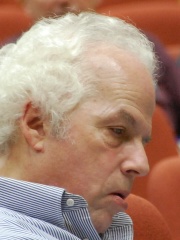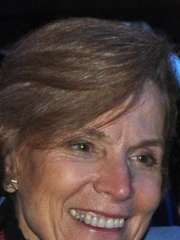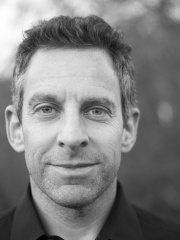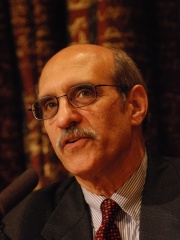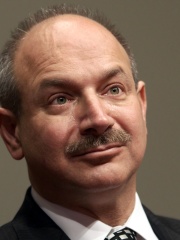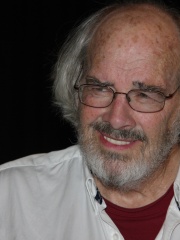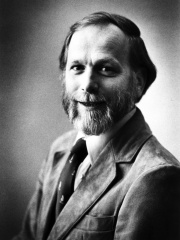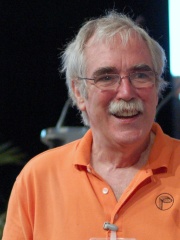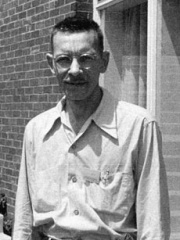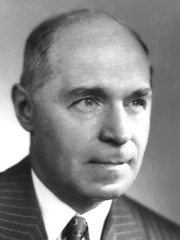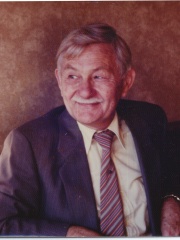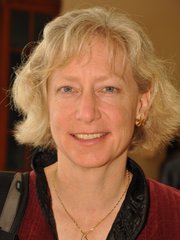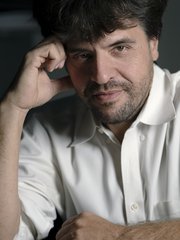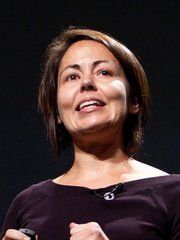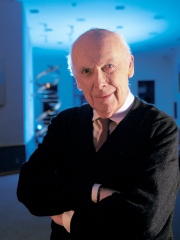
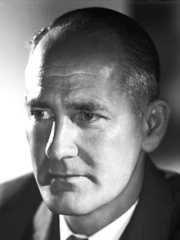
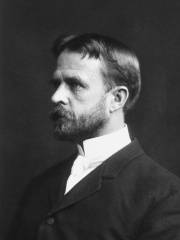
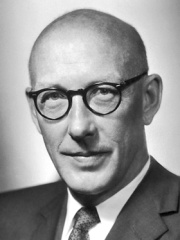
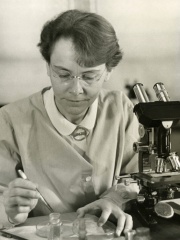
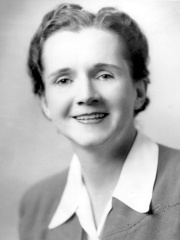
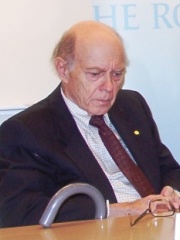

The Most Famous
BIOLOGISTS from United States
This page contains a list of the greatest American Biologists. The pantheon dataset contains 1,097 Biologists, 197 of which were born in United States. This makes United States the birth place of the most number of Biologists.
Top 10
The following people are considered by Pantheon to be the top 10 most legendary American Biologists of all time. This list of famous American Biologists is sorted by HPI (Historical Popularity Index), a metric that aggregates information on a biography's online popularity. Visit the rankings page to view the entire list of American Biologists.

1. James Watson (1928 - 2025)
With an HPI of 83.14, James Watson is the most famous American Biologist. His biography has been translated into 86 different languages on wikipedia.
James Dewey Watson (April 6, 1928 – November 6, 2025) was an American molecular biologist, geneticist, and zoologist. In 1953, he and Francis Crick co-authored an academic paper in Nature proposing the double helix structure of the DNA molecule, building on research by Rosalind Franklin and Raymond Gosling. In 1962, Watson, Crick, and Maurice Wilkins were awarded the Nobel Prize in Physiology or Medicine "for their discoveries concerning the molecular structure of nucleic acids and its significance for information transfer in living material". Watson graduated from the University of Chicago in 1947 and received his doctorate from Indiana University Bloomington in 1950. After a post-doctoral year at the University of Copenhagen with Herman Kalckar and Ole Maaløe, Watson worked at the University of Cambridge's Cavendish Laboratory in England, where he met his future collaborator Francis Crick. From 1956 to 1976, Watson was employed by the faculty of the Harvard University Biology Department, promoting research in molecular biology. From 1968, Watson served as the director of the Cold Spring Harbor Laboratory (CSHL) in Laurel Hollow, New York, greatly expanding its level of funding and research. At CSHL, he shifted his research emphasis to the study of cancer, along with making it a world-leading research center in molecular biology. In 1994, Watson started as president and served for 10 years. He was then appointed chancellor, serving until his resignation in 2007 after making comments claiming that there is a genetic link between race and intelligence. In 2019, after the broadcast of a documentary where Watson reiterated these views on race and genetics, CSHL revoked his honorary titles and severed all ties with him. Watson wrote many science books, including the textbook Molecular Biology of the Gene (1965) and his bestselling book The Double Helix (1968). He made derogatory comments about Rosalind Franklin, who had been responsible for gathering data that led to the discovery of the structure of DNA, and was criticized for misogyny. Between 1988 and 1992, Watson was associated with the National Institutes of Health, helping to establish the Human Genome Project, which completed the task of mapping the human genome in 2003.

2. George Beadle (1903 - 1989)
With an HPI of 77.63, George Beadle is the 2nd most famous American Biologist. His biography has been translated into 56 different languages.
George Wells Beadle (October 22, 1903 – June 9, 1989) was an American geneticist. In 1958 he shared one-half of the Nobel Prize in Physiology or Medicine with Edward Tatum for their discovery of the role of genes in regulating biochemical events within cells. He served as the 7th president of the University of Chicago from 1961 to 1968. Beadle and Tatum's key experiments involved exposing the bread mold Neurospora crassa to x-rays, causing mutations. In a series of experiments, they showed that these mutations caused changes in specific enzymes involved in metabolic pathways. These experiments led them to propose a direct link between genes and enzymatic reactions, known as the One gene-one enzyme hypothesis.

3. Thomas Hunt Morgan (1866 - 1945)
With an HPI of 76.71, Thomas Hunt Morgan is the 3rd most famous American Biologist. His biography has been translated into 73 different languages.
Thomas Hunt Morgan (September 25, 1866 – December 4, 1945) was an American evolutionary biologist, geneticist, embryologist, and science author who won the Nobel Prize in Physiology or Medicine in 1933 for discoveries elucidating the role that the chromosome plays in heredity. Morgan received his Ph.D. from Johns Hopkins University in zoology in 1890 and researched embryology during his tenure at Bryn Mawr. Following the rediscovery of Mendelian inheritance in 1900, Morgan began to study the genetic characteristics of the fruit fly Drosophila melanogaster. In his famous Fly Room at Columbia University's Schermerhorn Hall, Morgan demonstrated that genes are carried on chromosomes and are the mechanical basis of heredity. These discoveries formed the basis of the modern science of genetics. During his distinguished career, Morgan wrote 22 books and 370 scientific papers. As a result of his work, Drosophila became a major model organism in contemporary genetics. The Division of Biology which he established at the California Institute of Technology has produced seven Nobel Prize winners.

4. Edward Tatum (1909 - 1975)
With an HPI of 76.34, Edward Tatum is the 4th most famous American Biologist. His biography has been translated into 52 different languages.
Edward Lawrie Tatum (December 14, 1909 – November 5, 1975) was an American geneticist. He shared half of the Nobel Prize in Physiology or Medicine in 1958 with George Beadle for showing that genes control individual steps in metabolism. The other half of that year's award went to Joshua Lederberg. Tatum was an elected member of the United States National Academy of Sciences, the American Philosophical Society, and the American Academy of Arts and Sciences.
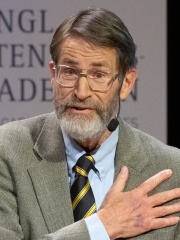
5. George Smith (b. 1941)
With an HPI of 74.77, George Smith is the 5th most famous American Biologist. His biography has been translated into 49 different languages.
George Pearson Smith (born 10 March 1941) is an American biologist and Nobel laureate. He is a Curators' Distinguished Professor Emeritus of Biological Sciences at the University of Missouri in Columbia, Missouri, US.

6. Barbara McClintock (1902 - 1992)
With an HPI of 74.62, Barbara McClintock is the 6th most famous American Biologist. Her biography has been translated into 81 different languages.
Barbara McClintock (June 16, 1902 – September 2, 1992) was an American scientist and cytogeneticist who was awarded the 1983 Nobel Prize in Physiology or Medicine. McClintock received her PhD in botany from Cornell University in 1927. There she started her career as the leader of the development of maize cytogenetics, the focus of her research for the rest of her life. From the late 1920s, McClintock studied chromosomes and how they change during reproduction in maize. She developed the technique for visualizing maize chromosomes and used microscopic analysis to demonstrate many fundamental genetic ideas. One of those ideas was the notion of genetic recombination by crossing-over during meiosis—a mechanism by which chromosomes exchange information. She is often erroneously credited with producing the first genetic map for maize, linking regions of the chromosome to physical traits. She demonstrated the role of the telomere and centromere, regions of the chromosome that are important in the conservation of genetic information. She was recognized as among the best in the field, awarded prestigious fellowships, and elected a member of the National Academy of Sciences in 1944. During the 1940s and 1950s, McClintock discovered transposons and used it to demonstrate that genes are responsible for turning physical characteristics on and off. She developed theories to explain the suppression and expression of genetic information from one generation of maize plants to the next. Due to skepticism of her research and its implications, she stopped publishing her data in 1953. Later, she made an extensive study of the cytogenetics and ethnobotany of maize races from South America. McClintock's research became well understood in the 1960s and 1970s, as other scientists confirmed the mechanisms of genetic change and protein expression that she had demonstrated in her maize research in the 1940s and 1950s. Awards and recognition for her contributions to the field followed, including the Nobel Prize in Physiology or Medicine, awarded to her in 1983 for the discovery of genetic transposition; as of 2025, she remains the only woman who has received an unshared Nobel Prize in that category.

7. Rachel Carson (1907 - 1964)
With an HPI of 74.42, Rachel Carson is the 7th most famous American Biologist. Her biography has been translated into 91 different languages.
Rachel Louise Carson (May 27, 1907 – April 14, 1964) was an American marine biologist, writer, and conservationist whose sea trilogy (1941–1955) and book Silent Spring (1962) are credited with advancing marine conservation and the global environmental movement. Carson began her career as an aquatic biologist in the U.S. Bureau of Fisheries, and became a full-time nature writer in the 1950s. Her widely praised 1951 bestseller The Sea Around Us won her a U.S. National Book Award, recognition as a gifted writer, and financial security. Its success prompted the republication of her first book, Under the Sea Wind (1941), in 1952, which was followed by The Edge of the Sea in 1955 — both were also bestsellers. This sea trilogy explores the whole of ocean life from the shores to the depths. Late in the 1950s, Carson turned her attention to conservation, especially some problems she believed were caused by synthetic pesticides. The result was the book Silent Spring (1962), which brought environmental concerns to an unprecedented share of the American people. Although Silent Spring was met with fierce opposition by chemical companies, it spurred a reversal in national pesticide policy, which led to a nationwide ban on DDT and other pesticides. It also inspired a grassroots environmental movement that led to the creation of the U.S. Environmental Protection Agency. Carson was posthumously awarded the Presidential Medal of Freedom by President Jimmy Carter.

8. Irwin Rose (1926 - 2015)
With an HPI of 73.60, Irwin Rose is the 8th most famous American Biologist. His biography has been translated into 57 different languages.
Irwin Allan Rose (July 16, 1926 – June 2, 2015) was an American biologist. Along with Aaron Ciechanover and Avram Hershko, he was awarded the 2004 Nobel Prize in Chemistry for the discovery of ubiquitin-mediated protein degradation.

9. Linda B. Buck (b. 1947)
With an HPI of 72.70, Linda B. Buck is the 9th most famous American Biologist. Her biography has been translated into 78 different languages.
Linda Brown Buck (born January 29, 1947) is an American biologist best known for her work on the olfactory system. She was awarded the 2004 Nobel Prize in Physiology or Medicine, along with Richard Axel, for their work on olfactory receptors. She is currently on the faculty of the Fred Hutchinson Cancer Research Center in Seattle.
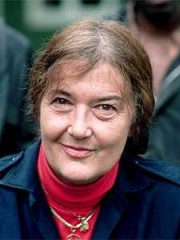
10. Dian Fossey (1932 - 1985)
With an HPI of 72.50, Dian Fossey is the 10th most famous American Biologist. Her biography has been translated into 66 different languages.
Dian Fossey (January 16, 1932 – c. December 26, 1985) was an American primatologist and conservationist known for undertaking an extensive study of mountain gorilla groups from 1966 until her murder in 1985. She studied them daily in the mountain forests of Rwanda, initially encouraged to work there by paleoanthropologist Louis Leakey. Gorillas in the Mist, a book published two years before her death, is Fossey's account of her scientific study of the gorillas at the Karisoke Research Center and prior career. It was adapted into a 1988 film of the same name. Fossey was a leading primatologist, and a member of the "Trimates", a group of female scientists recruited by Leakey to study great apes in their natural environments, along with Jane Goodall who studied chimpanzees, and Birutė Galdikas, who studies orangutans. Fossey spent 20 years in Rwanda, where she supported conservation efforts, strongly opposed poaching and tourism in wildlife habitats, and made more people acknowledge the sapience of gorillas. Following the killing of a gorilla and subsequent tensions, she was murdered in her cabin at a remote camp in Rwanda in December 1985. Although Fossey's American research assistant was convicted in absentia, there is no consensus as to who killed her. Her research and conservation work helped reduce the downward population trend in mountain gorillas.
People
Pantheon has 197 people classified as American biologists born between 1699 and 1977. Of these 197, 58 (29.44%) of them are still alive today. The most famous living American biologists include George Smith, Linda B. Buck, and Stanley B. Prusiner. The most famous deceased American biologists include James Watson, George Beadle, and Thomas Hunt Morgan. As of April 2024, 6 new American biologists have been added to Pantheon including Cornelia Bargmann, Gretchen Daily, and David Reich.
Living American Biologists
Go to all RankingsGeorge Smith
1941 - Present
HPI: 74.77
Linda B. Buck
1947 - Present
HPI: 72.70
Stanley B. Prusiner
1942 - Present
HPI: 70.20
Sylvia Earle
1935 - Present
HPI: 69.82
John Hopfield
1933 - Present
HPI: 69.81
Sam Harris
1967 - Present
HPI: 69.51
Martin Chalfie
1947 - Present
HPI: 68.37
Leland H. Hartwell
1939 - Present
HPI: 68.02
Bruce Beutler
1957 - Present
HPI: 67.13
Jack Horner
1946 - Present
HPI: 67.13
J. Michael Bishop
1936 - Present
HPI: 66.37
Eric F. Wieschaus
1947 - Present
HPI: 66.15
Deceased American Biologists
Go to all RankingsJames Watson
1928 - 2025
HPI: 83.14
George Beadle
1903 - 1989
HPI: 77.63
Thomas Hunt Morgan
1866 - 1945
HPI: 76.71
Edward Tatum
1909 - 1975
HPI: 76.34
Barbara McClintock
1902 - 1992
HPI: 74.62
Rachel Carson
1907 - 1964
HPI: 74.42
Irwin Rose
1926 - 2015
HPI: 73.60
Dian Fossey
1932 - 1985
HPI: 72.50
Clair Cameron Patterson
1922 - 1995
HPI: 71.25
Alfred Hershey
1908 - 1997
HPI: 71.22
Hermann Joseph Muller
1890 - 1967
HPI: 70.15
John B. Calhoun
1917 - 1995
HPI: 69.91
Newly Added American Biologists (2025)
Go to all RankingsCornelia Bargmann
1961 - Present
HPI: 42.45
Gretchen Daily
1964 - Present
HPI: 41.01
David Reich
1974 - Present
HPI: 38.12
Karl Deisseroth
1971 - Present
HPI: 38.11
Kim Cobb
HPI: 34.63
Beth Shapiro
1976 - Present
HPI: 33.38
Overlapping Lives
Which Biologists were alive at the same time? This visualization shows the lifespans of the 25 most globally memorable Biologists since 1700.

